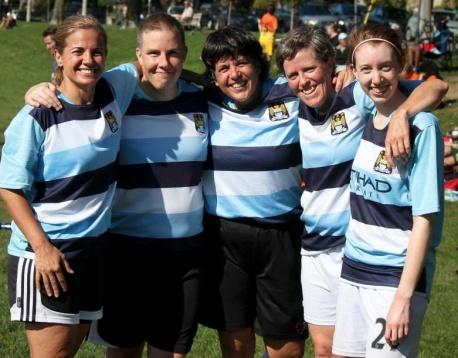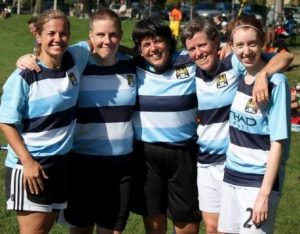 Thirty years and growing strong, Toronto’s non-profit, recreational women’s Pink Turf Soccer League has grown and evolved—adapted while staying true to its early grassroots LGBT, feminist, egalitarian philosophies. Pink Turf began in early 1985 as the brainchild of three friends following a hockey game. Shawna Strickland, Linda Copping and Kelley Sublette had never played organized soccer but wanted to learn more about the sport and play with their friends on a regular basis. With Anne Verral, they set out to do just that, placing a callout in Xtra and Broadside, for ’65, women-identified women to play, coach and/or officiate’…’Vast experience not essential.’ Registration forms were available at The Toronto Women’s Bookstore (which closed in 2012 after 39 years as a female, collectively-run business), and the first meeting was held in April 1985 at The 519 Church Street Community Centre. $25 bought a team shirt and socks, field time and equipment, game officiating and a team coach. In the first year, over 80 women responded and four teams were formed: The Zephyrs, The Wolfpack, Red Emma and The Panthers.
Thirty years and growing strong, Toronto’s non-profit, recreational women’s Pink Turf Soccer League has grown and evolved—adapted while staying true to its early grassroots LGBT, feminist, egalitarian philosophies. Pink Turf began in early 1985 as the brainchild of three friends following a hockey game. Shawna Strickland, Linda Copping and Kelley Sublette had never played organized soccer but wanted to learn more about the sport and play with their friends on a regular basis. With Anne Verral, they set out to do just that, placing a callout in Xtra and Broadside, for ’65, women-identified women to play, coach and/or officiate’…’Vast experience not essential.’ Registration forms were available at The Toronto Women’s Bookstore (which closed in 2012 after 39 years as a female, collectively-run business), and the first meeting was held in April 1985 at The 519 Church Street Community Centre. $25 bought a team shirt and socks, field time and equipment, game officiating and a team coach. In the first year, over 80 women responded and four teams were formed: The Zephyrs, The Wolfpack, Red Emma and The Panthers. 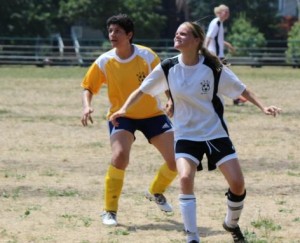 Given the need for gay and lesbian safe space and the lack of recreational sport for women, Pink Turf’s focus was two-fold: LGBT social justice; and the opportunity for women to play and develop soccer skills in an egalitarian, accessible, consensus-driven atmosphere. Sliding scale was available. The League was organized cooperatively and run by a volunteer Collective, with decisions made through discussion and consensus.
Given the need for gay and lesbian safe space and the lack of recreational sport for women, Pink Turf’s focus was two-fold: LGBT social justice; and the opportunity for women to play and develop soccer skills in an egalitarian, accessible, consensus-driven atmosphere. Sliding scale was available. The League was organized cooperatively and run by a volunteer Collective, with decisions made through discussion and consensus. 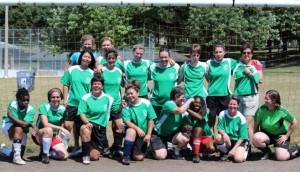 Jocelyn Piercy, who has played in Pink Turf since its second season and was on the Collective from about 1987 to 1995, emphasizes the importance of the league in the early years: ‘Pink Turf was a place to be OUT before the term existed…where PRIDE was tables behind the 519 and we had a table to sell T-shirts…where gay bashing was traditionally prominent on Halloween night in Toronto and one year Pink Turf members joined other marchers to try to make the streets safer.’
Jocelyn Piercy, who has played in Pink Turf since its second season and was on the Collective from about 1987 to 1995, emphasizes the importance of the league in the early years: ‘Pink Turf was a place to be OUT before the term existed…where PRIDE was tables behind the 519 and we had a table to sell T-shirts…where gay bashing was traditionally prominent on Halloween night in Toronto and one year Pink Turf members joined other marchers to try to make the streets safer.’ 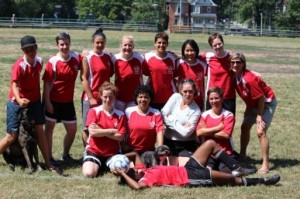 By 1987, Pink Turf had grown to 120 players and five teams: the season’s team names included Orange Crush and The Green Machine. Membership in 1995 was steady at 120 members, five teams and a waiting list. By the late ‘90s, play within the league improved and the league attracted higher skilled players with greater knowledge of the game. Slide-tackles became common, but intimidated less skilled players. The league reached a crossroads. After much deliberation, the Collective opted to maintain the recreational grassroots beginnings of the league and banned slide-tackles. Some players didn’t like the change and left.
By 1987, Pink Turf had grown to 120 players and five teams: the season’s team names included Orange Crush and The Green Machine. Membership in 1995 was steady at 120 members, five teams and a waiting list. By the late ‘90s, play within the league improved and the league attracted higher skilled players with greater knowledge of the game. Slide-tackles became common, but intimidated less skilled players. The league reached a crossroads. After much deliberation, the Collective opted to maintain the recreational grassroots beginnings of the league and banned slide-tackles. Some players didn’t like the change and left. 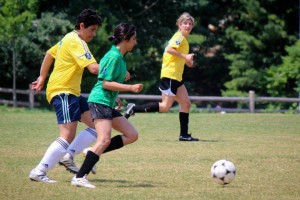 In 2000, Pink Turf self-described as a ‘recreational soccer league of lesbian and lesbian-positive women of diverse age, race, experience and athletic ability,’ with an aim to, ‘gain soccer skills, and enjoy fitness and friendly competition.’
In 2000, Pink Turf self-described as a ‘recreational soccer league of lesbian and lesbian-positive women of diverse age, race, experience and athletic ability,’ with an aim to, ‘gain soccer skills, and enjoy fitness and friendly competition.’ 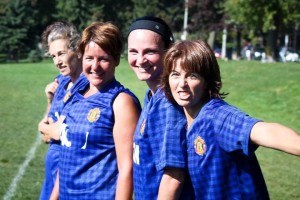 From May to September, almost every year, the League played at Withrow Park in Toronto’s Greektown, south of the Danforth between Logan and Carlaw, and between Chester and Pape Subway stations. Cindy Worsley used to live on Pape Avenue, and walking past Withrow Park one Saturday, she noticed a group of women playing soccer and having FUN. Speaking to a friendly player, she learned the league was Pink Turf, joined in 2001 and has been on the Collective since 2012. Although the overwhelming majority of the league remains queer, she describes herself as ‘one of the growing straight girl population.’ Cindy emphasizes the league’s twofold, ‘raison d’être—soccer and queer community—and the importance of encouraging new queer players and reinforcing the queer aspect of the league: holding registration/information night in The Village; promoting social events; organizing the end-of-season banquet; participating in PRIDE; and partnering with OutSport Toronto. We’ve also made donations to queer-positive causes over the years.’ The League is highly organized, with a Collective that meets monthly during soccer season, a Social Committee, an Arbitration Committee and Team Reps for every team. New members are required to sign a Code of Conduct committing to the queer-positive, inclusive nature of the league and the objective of playing for FUN!
From May to September, almost every year, the League played at Withrow Park in Toronto’s Greektown, south of the Danforth between Logan and Carlaw, and between Chester and Pape Subway stations. Cindy Worsley used to live on Pape Avenue, and walking past Withrow Park one Saturday, she noticed a group of women playing soccer and having FUN. Speaking to a friendly player, she learned the league was Pink Turf, joined in 2001 and has been on the Collective since 2012. Although the overwhelming majority of the league remains queer, she describes herself as ‘one of the growing straight girl population.’ Cindy emphasizes the league’s twofold, ‘raison d’être—soccer and queer community—and the importance of encouraging new queer players and reinforcing the queer aspect of the league: holding registration/information night in The Village; promoting social events; organizing the end-of-season banquet; participating in PRIDE; and partnering with OutSport Toronto. We’ve also made donations to queer-positive causes over the years.’ The League is highly organized, with a Collective that meets monthly during soccer season, a Social Committee, an Arbitration Committee and Team Reps for every team. New members are required to sign a Code of Conduct committing to the queer-positive, inclusive nature of the league and the objective of playing for FUN! 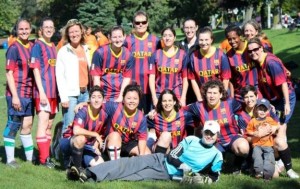 To reduce incidents and encourage positive recreational spirit, a Fair Play Policy/Aggression Policy was developed and adopted. To discourage cliques and widen the community within Pink Turf, team membership is changed every year. Current player’s ages range from 18 years to late 50s, with one woman playing into her 68th year. Team shirts have varied over the years, from different colours to International team designs. Robert Cruise, Pink Turf’s referee for the first fifteen years supported the grassroots goals of the league. As the league grew from two, to three, to five Saturday games, additional refs were required. John Karapostolaris is another longstanding friend of the league and a current ref. On a new player’s illegal throw-in, John will often call foul, tell her how to fix her throw and allow her to try again (instead of her team losing possession). No one blinks at this typical act of skill development over competitive play.
To reduce incidents and encourage positive recreational spirit, a Fair Play Policy/Aggression Policy was developed and adopted. To discourage cliques and widen the community within Pink Turf, team membership is changed every year. Current player’s ages range from 18 years to late 50s, with one woman playing into her 68th year. Team shirts have varied over the years, from different colours to International team designs. Robert Cruise, Pink Turf’s referee for the first fifteen years supported the grassroots goals of the league. As the league grew from two, to three, to five Saturday games, additional refs were required. John Karapostolaris is another longstanding friend of the league and a current ref. On a new player’s illegal throw-in, John will often call foul, tell her how to fix her throw and allow her to try again (instead of her team losing possession). No one blinks at this typical act of skill development over competitive play. 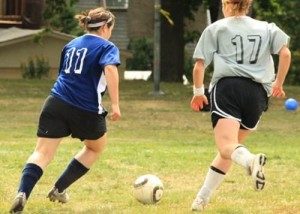 ‘Mercy Etiquette’ applies if a team is up by four goals—the winning team is encouraged to increase their passing, switch players into unfamiliar positions, decrease shots on net and retrieve out-of-bound balls. One year the Collective introduced a Team Spirit Award for the team with the most players that scored a goal. Each season finishes with League playoffs and a year-end banquet. Now, in 2015 the league has 250 players and 11 teams. Although another team was added this year, there is still a waiting list. $110 buys a team shirt with the player’s name on the back, field time and equipment, game officiating and organized weekly practices. It is still sliding scale.
‘Mercy Etiquette’ applies if a team is up by four goals—the winning team is encouraged to increase their passing, switch players into unfamiliar positions, decrease shots on net and retrieve out-of-bound balls. One year the Collective introduced a Team Spirit Award for the team with the most players that scored a goal. Each season finishes with League playoffs and a year-end banquet. Now, in 2015 the league has 250 players and 11 teams. Although another team was added this year, there is still a waiting list. $110 buys a team shirt with the player’s name on the back, field time and equipment, game officiating and organized weekly practices. It is still sliding scale.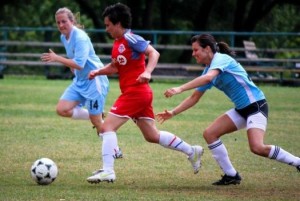 Although thirty years has seen significant societal changes (increased opportunities for women in sport and improved LGBT conditions in Toronto), Jocelyn Piercy says, ‘It’s amazing how the league, even with a complete changeover of people and a generation, has stayed very close to its originator’s goals, its collective grass roots and philosophy of equal access. And the League’s models and policies are now all written down, tested, so they won’t fade with a change in people.’ For Pink Turf, ‘community’ includes all those who share in the success of the League and its growth: the LGBT community; friends, lovers and partners within the league; our straight allies; the Withrow Park neighbourhood; and the League’s relationship with Toronto Parks, Forestry and Recreation.
Although thirty years has seen significant societal changes (increased opportunities for women in sport and improved LGBT conditions in Toronto), Jocelyn Piercy says, ‘It’s amazing how the league, even with a complete changeover of people and a generation, has stayed very close to its originator’s goals, its collective grass roots and philosophy of equal access. And the League’s models and policies are now all written down, tested, so they won’t fade with a change in people.’ For Pink Turf, ‘community’ includes all those who share in the success of the League and its growth: the LGBT community; friends, lovers and partners within the league; our straight allies; the Withrow Park neighbourhood; and the League’s relationship with Toronto Parks, Forestry and Recreation. 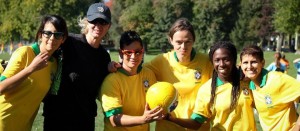 So, if you’re a ‘lesbian, bisexual, trans and queer-positive woman, of any age, race, experience and athletic ability,’ and you want to play in a league whose goal is to ‘make all players feel welcome while promoting equity, fair play, respect and fun,’ then tie up your cleats and head on over to the Withrow Pitch—there’s a soccer team waiting for you. Thirty years and counting…
So, if you’re a ‘lesbian, bisexual, trans and queer-positive woman, of any age, race, experience and athletic ability,’ and you want to play in a league whose goal is to ‘make all players feel welcome while promoting equity, fair play, respect and fun,’ then tie up your cleats and head on over to the Withrow Pitch—there’s a soccer team waiting for you. Thirty years and counting…
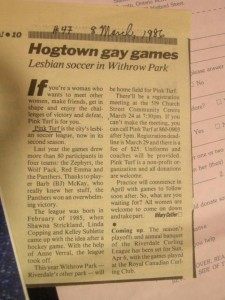 Information on Pink Turf currently on file at The ArQuives (The ArQuives), includes the initial ads for the league in Xtra and Broadside, Xtra articles from 1986 and 1995, Registration forms from 1988, 2000 and 2004, a 1989 Newsletter and an excerpt from the 1987 winter issue of the Canadian Association for the Advancement of Women in Sport by Lorraine McKay. Additional information, photos, etc., would be gratefully accepted by The ArQuives. The 1986 Xtra article and the 1988 Registration form were on display this July and August as part of Pride HouseTO’s Toronto LGBTQ Sport History Exhibit at the 519 for the 2015 Pan/Parapan Am Games. Author: Janice Martin, The ArQuives volunteer and Pink Turf player since 2000. Janice’s late partner Karin Lapins played in the late ‘80s and from 2003 to 2011, and her daughter played in 2009. Photo Credits: Kirsti Racine (used with permission).
Information on Pink Turf currently on file at The ArQuives (The ArQuives), includes the initial ads for the league in Xtra and Broadside, Xtra articles from 1986 and 1995, Registration forms from 1988, 2000 and 2004, a 1989 Newsletter and an excerpt from the 1987 winter issue of the Canadian Association for the Advancement of Women in Sport by Lorraine McKay. Additional information, photos, etc., would be gratefully accepted by The ArQuives. The 1986 Xtra article and the 1988 Registration form were on display this July and August as part of Pride HouseTO’s Toronto LGBTQ Sport History Exhibit at the 519 for the 2015 Pan/Parapan Am Games. Author: Janice Martin, The ArQuives volunteer and Pink Turf player since 2000. Janice’s late partner Karin Lapins played in the late ‘80s and from 2003 to 2011, and her daughter played in 2009. Photo Credits: Kirsti Racine (used with permission).

